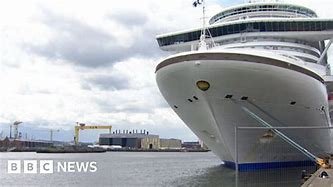Belfast Harbour to Invest £90m to Boost Cruise Ship Industry and Wind Energy Development

Belfast Harbour is set to invest £90 million to enhance its facilities for both the cruise ship industry and the growing wind energy sector. This significant investment aims to transform the port into a key player in the cruise tourism market by encouraging more cruises to start and finish in Belfast, rather than just stopping for a single day.
This initiative is part of a broader £300 million spending plan by the harbour over the next five years, aimed at modernizing infrastructure and supporting economic growth. The proposed upgrades include relocating the cruise terminal to an undeveloped site on Airport Road West, which will allow the port to accommodate “turnaround cruises.” These are cruises where passengers board in Belfast, enjoy a week-long voyage, and then return to the same port.
Joe O’Neill, the CEO of Belfast Harbour, explained, “Part of our ambition is to do what are called turnaround cruises. That’s where people come here, they board, they do a seven-day cruise, and return. To cater for that segment of the market, we need more substantial facilities, an airport-type terminal.” The move is expected to significantly increase the number of cruise passengers arriving in Belfast, with tourism experts predicting the local economy could benefit from an even greater influx of tourists.
In 2024, almost 150 cruise ships visited Belfast, bringing 260,000 passengers and crew. Joe O’Neill and John McGrillen, CEO of Tourism NI, emphasized that this investment could greatly enhance the economic contribution of cruise tourism to Northern Ireland, which currently generates around £25 million annually. McGrillen pointed out, “If the ambition to turn Belfast into a turnaround port happens, we can see that contribution double or even treble over the next 20 or 30 years.”
Tourism in Northern Ireland extends beyond Belfast, with cruise tourists contributing significantly to smaller local attractions. Many passengers take coaches, buses, and taxis from the cruise terminal to visit areas along the coast and other attractions, which generates additional economic activity throughout the region.
The harbour’s ambitious plans also include expanding its existing marshalling area for wind turbines. The site currently has planning permission for the new cruise terminal, and officials hope it will be operational by late 2027 or early 2028. This move will free up space for future developments, including a focus on offshore wind energy, a sector poised for growth in the coming years. O’Neill highlighted, “We envisage about 30 different wind farm projects over the next 10 years or so in our natural trading hinterland.”
Although Belfast Harbour’s current investment is funded by its retained earnings, the port is keen to borrow money for larger projects. However, its legal status as a public corporation limits its borrowing capacity, as any debt taken on counts toward Stormont’s capital budget. The harbour is seeking a legal change to reclassify itself as a private corporation, which would grant it the ability to borrow more freely for large-scale projects. A similar reclassification has already been achieved by ports in Scotland, and the Department of Infrastructure has launched a consultation on the issue to explore potential changes in Northern Ireland’s laws.
This investment and the associated legal changes aim to position Belfast Harbour as a significant hub for both the cruise and wind energy sectors, creating new opportunities for local businesses, tourism, and green energy initiatives.










